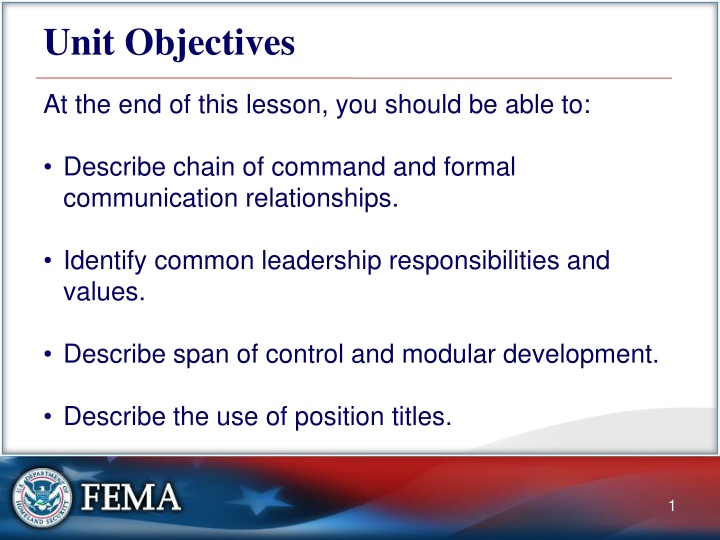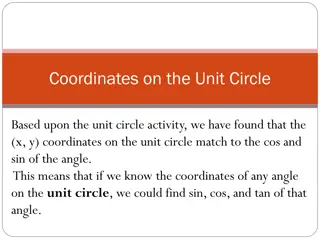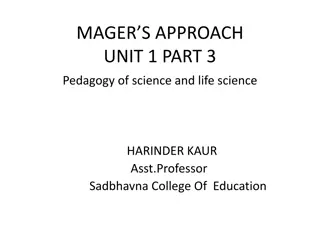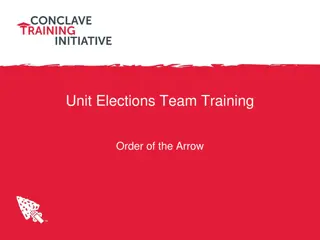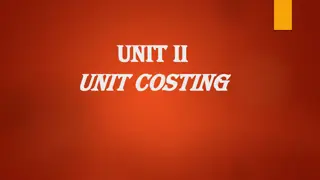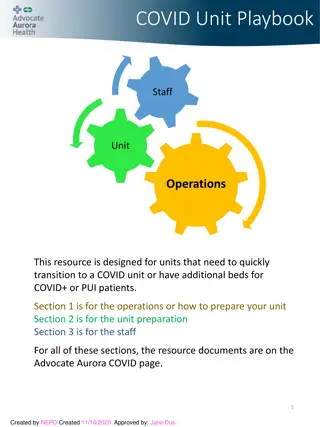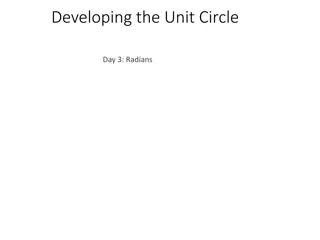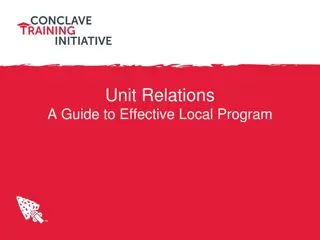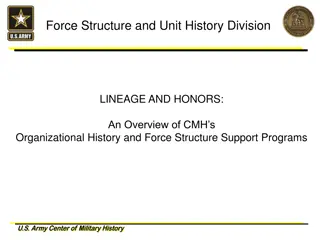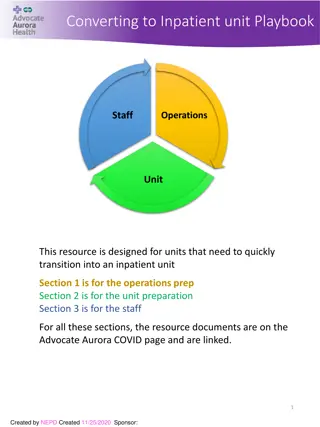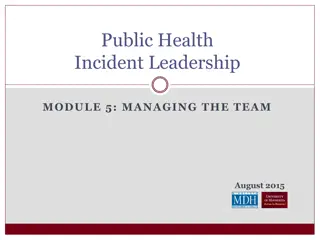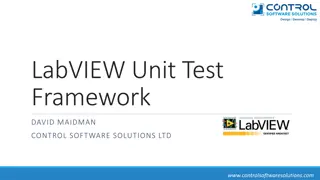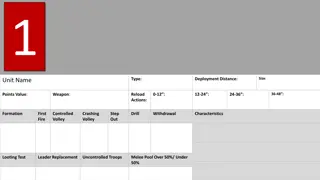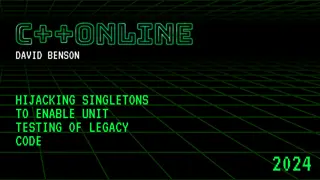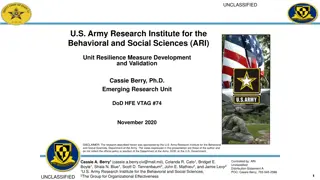Unit Objectives
Learn about the importance of chain of command, unity of command, and unified command in organizational leadership. Discover how these concepts help establish clear communication, streamline decision-making, and optimize resource management during incidents. Explore the advantages of using unified command for effective incident response and collaboration across multiple agencies.
Download Presentation

Please find below an Image/Link to download the presentation.
The content on the website is provided AS IS for your information and personal use only. It may not be sold, licensed, or shared on other websites without obtaining consent from the author.If you encounter any issues during the download, it is possible that the publisher has removed the file from their server.
You are allowed to download the files provided on this website for personal or commercial use, subject to the condition that they are used lawfully. All files are the property of their respective owners.
The content on the website is provided AS IS for your information and personal use only. It may not be sold, licensed, or shared on other websites without obtaining consent from the author.
E N D
Presentation Transcript
Unit Objectives At the end of this lesson, you should be able to: Describe chain of command and formal communication relationships. Identify common leadership responsibilities and values. Describe span of control and modular development. Describe the use of position titles. 1
Chain of Command An orderly line of authority is used for the flow of task assignments and resource requests. This line of authority flows down through the organizational structure. 2
Unity of Command Unity of command means that each individual involved in incident operations will be assigned and will report to only one supervisor. Chain of command and unity of command help to ensure that clear reporting relationships exist and eliminate the confusion caused by multiple, conflicting directives. Incident managers at all levels must be able to control the actions of all personnel under their supervision. Unity of command clears up many of the potential communication problems encountered in managing incidents or events because each individual maintains a formal communication relationship only with his or her immediate supervisor. Don't confuse unity of command with Unified Command! 3
Unified Command (1 of 2) When no one jurisdiction, agency, or organization has primary authority and/or the resources to manage an incident on its own, Unified Command may be established. There is no one "Commander." The Unified Command can allocate resources regardless of ownership or location. This illustration shows three responsible agencies managing an incident together under a Unified Command. 4
Unified Command (2 of 2) Unified Command: Enables all responsible agencies to manage an incident together by establishing a common set of incident objectives and strategies Allows Incident Commanders to make joint decisions by establishing a single command structure at one Incident Command Post (ICP) Maintains Unity of Command. Each employee reports to only one supervisor 5
Advantages of Unified Command Advantages of using Unified Command include: A single set of objectives guides incident response. A collective approach is used to develop strategies to achieve incident objectives. Information flow and coordination are improved between all involved in the incident. All agencies have an understanding of joint priorities and restrictions. No agency's legal authorities will be compromised or neglected. Agencies' efforts are optimized as they perform their respective assignments under a single Incident Action Plan. 6
ACTIVITY 2.1: UNIFIED COMMAND Activity Purpose: To practice recognizing potential incident management issues. Time: 15 minutes Instructions: Working with your team 1. Read the scenario in your Student Manual. 2. Identify the potential incident management issues. 3. List the incident management issues on chart paper. 4. Choose a spokesperson. Be prepared to present your findings to the class in 10 minutes. Scenario: A tornado collapsed a building, trapping 15 people in its basement. Fire department officers immediately designated a fire station located directly across from the incident site as the Incident Command Post (ICP). However, the fire stations confined location and immediate proximity to the incident made it ill-suited for directing the large-scale response effort. As police officers arrived on the scene, they decided to establish their Command Center at a school, several blocks away from the immediate response activities. As response operations progressed and a mobile command vehicle became available, the Incident Command Post (ICP) was established in that vehicle just north of the hospital. Other agencies involved, such as the fire department and emergency medical services, began operating near the new ICP location and Incident Commander. The police department continued to operate from the school. 7
Integrated Communications Overview Formal communications follow the lines of authority. However, information concerning incident or event can be passed horizontally or vertically within the organization without restriction. 8
Formal Communication As illustrated on the previous screen, formal communication must be used when: Receiving and giving work assignments Requesting support or additional resources Reporting progress of assigned tasks Other information concerning the incident or event can be passed horizontally or vertically within the organization without restriction. This is known as informal communication. 9
Informal Communication Informal communication: Is used to exchange incident or event information only Is NOT used for: Formal requests for additional resources Tasking work assignments Within the ICS organization, critical information must flow freely! 10
Informal Communication (Continued) Examples of informal communication are as follows: The Communications Unit Leader may directly contact the Resources Unit Leader to determine the number of persons requiring communications devices. The Cost Unit Leader may directly discuss and share information on alternative strategies with the Planning Section Chief. 11
ACTIVITY 2.2: INCIDENT COMMUNICATIONS Activity Purpose: To practice identifying communication strategies to avoid problems during incident operations. Time: 15 minutes Instructions: Working with your team 1. Read the scenario in your Student Manual. 2. Identify strategies to address the communications problem. 3. List the strategies on chart paper. 4. Choose a spokesperson. Be prepared to present your findings to the class in 10 minutes. Case Scenario: Emergency communications at the Pentagon site proved challenging on September 11, 2001. Radio communications among emergency responders quickly became overloaded. These communication problems persisted throughout rescue operations. There was a need to record the identification number and location of each piece of equipment on the Pentagon grounds. Radio communications could not be employed to perform this task. 12
Discussion Question Why is leadership an essential element of successful incident/event management? 13
Common Leadership Responsibilities A good leader: Communicatesby giving specific instructions and asking for feedback. Supervises the scene of action. Evaluatesthe effectiveness of the plan. Understandsand acceptsthe need to modify plans or instructions. Ensuressafe work practices. Takes commandof assigned resources. Motivates with a "can do safely" attitude. Demonstratesinitiative by taking action. 14
Leadership & Values A leader commits to excellence in all aspects of his or her professional responsibility. Leaders should know, understand, and practice the leadership responsibilities and recognize the relationship between these responsibilities and the leadership values. Commitment to duty, respect, and integrity are essential values that must be demonstrated in order for a leader to be effective. 15
Commitment to Duty Duty begins with everything required by law and policy, but it is much more than simply fulfilling requirements. How does an effective leader demonstrate commitment to duty to those he or she leads? An effective leader should try to: Take charge within his or her scope of authority. Be prepared to step out of a tactical role to assume a leadership role. Be proficient in his or her job. Make sound and timely decisions. Ensure tasks are understood. Develop subordinates for future events. 16
Discussion Question What can you do to demonstrate your commitment to duty to those you lead? 17
Leadership & Respect In order to maintain leadership and respect, a leader should: Know his or her subordinates and look out for their well-being. A leader s workforce is his or her greatest resource. Not all workers will succeed equally, but they all deserve respect. Keep his or her subordinates and supervisor informed by providing accurate and timely briefings and giving the intent behind assignments and tasks. Build the team. Conducting frequent briefings and debriefings with the team enables a leader to monitor progress and identify lessons learned. Considerations made during these meetings should include team experience, fatigue, and physical limitations when accepting assignments. 18
ACTIVITY 2.3: INCIDENT LEADERSHIP Activity Purpose: To stimulate thought and discussion about desirable leadership qualities. Time: 20 minutes Instructions: Working with your team 1.Identify a highly effective incident leader you have known or know about. 2.List the main leadership qualities that such an individual must possess. 3.State how these qualities relate to leadership in incident response. 4.Choose a spokesperson. Be prepared to present your findings to the class in 5 minutes. 19
Communication Responsibilities To ensure sharing of critical information, all responders must: Brief others as needed Debrief their actions Communicate hazards to others Acknowledge messages Ask if they do not know While not always possible, the most effective form of communication is face-to-face. 20
Briefing Elements Provide complete briefings that include clearly stated objectives and the following elements: 21
Incident Management Assessment Assessment is an important leadership responsibility and is conducted after a major activity in order to allow employees and leaders to discover what happened and why. Assessment methods include: Corrective action report/After- Action Review (AAR) Debriefing Post-incident critique Mitigation plans 22
Discussion Question What questions would you use to assess the effectiveness of incident management? 23
Using Common Terminology ICS establishes common terminology that allows diverse incident management and support entities to work together. Major functions and functional units with incident management responsibilities are named and defined. Terminology for the organizational elements involved is standard and consistent. 24
ICS Organization: Review The ICS organization: Is typically structured to facilitate activities in five major functional areas: Command, Operations, Planning, Logistics, and Finance/Administration Is adaptable to any emergency or incident to which domestic incident management agencies would be expected to respond Has a scalable organizational structure that is based on the size and complexity of the incident However, this flexibility does NOT allow for the modification of the standard, common language used to refer to organizational components or positions. 25
ICS Organization: Review (Continued) Who's responsible for what? 26
NIMS Management: Manageable Span of Control The optimal span of control for incident management is one supervisor to five subordinates; however, effective incident management frequently necessitates ratios significantly different from this. The 1:5 ratio is a guideline, and incident personnel use their best judgment to determine the actual distribution of subordinates to supervisors for a given incident or EOC activation. 27
Span of Control What influences span of control? 28
Modular Organization The ICS organization adheres to a "form follows function" philosophy. The size of the current organization and that of the next operational period is determined through the incident planning process. Because the ICS is a modular concept, managing span of control is accomplished by organizing resources into Teams, Divisions, Groups, Branches, or Sections. When the supervisor-to-subordinate ratio exceeds manageable span of control, additional Teams, Divisions, Groups, Branches, or Sections can be established. When a supervisor is managing too few subordinates, Sections, Branches, Divisions, Groups, or Teams can be reorganized or demobilized to reach a more effective span of control. 29
Typical Organizational Structure The initial response to most domestic incidents is typically handled by local "911" dispatch centers, emergency responders within a single jurisdiction, and direct supporters of emergency responders. Most responses need go no further. Approximately 95% of all incidents are small responses that include: Command: Incident Commander and other Command Staff Single Resource: An individual, a piece of equipment and its personnel complement, or an established crew or team of individuals with an identified work supervisor that can be used on an incident 30
Expanding Incidents Incidents that begin with single resources may rapidly expand requiring significant additional resources and operational support. 31
Use of Position Titles At each level within the ICS organization, individuals with primary responsibility positions have distinct titles. Using specific ICS position titles serves these important purposes: Provides a common standard Ensures qualified individuals fill positions Ensures that requested personnel are qualified Standardizes communication Describes the responsibilities of the position 32
ICS Supervisory Position Titles Titles for all ICS supervisory levels are shown in the table below: Organizational Level Incident Command Title Support Position Deputy Incident Commander Officer Chief Command Staff General Staff (Section) Branch Division/Group Unit Strike Team/Task Force Assistant Deputy Director Supervisor Unit Leader Leader Deputy N/A Manager Single Resource Boss 33
Discussion Question How would you adjust the organizational strategy to maintain span of control for the scenario below? Be sure to use proper principles, position titles, and features. Scenario: The Command Staff consists of a Safety Officer and Public Information Officer. In the General Staff, the Operations Section has seven Strike Teams under the supervision of one Leader. Each Strike Team consists of a mix of different types of law enforcement and medical resources. 34
Lesson Completion You have completed the Incident Command and Unified Command lesson. You should now be able to: Describe chain of command and formal communication relationships. Identify common leadership responsibilities and values. Describe span of control and modular development. Describe the use of position titles. The next lesson will discuss delegation of authority and management by objectives. 35
